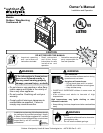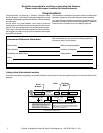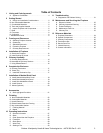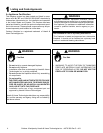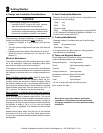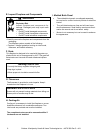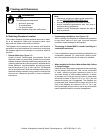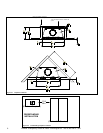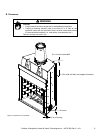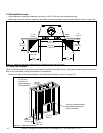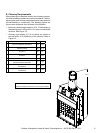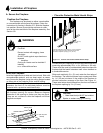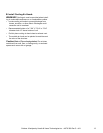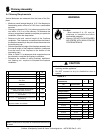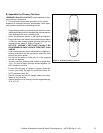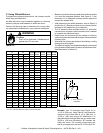Special offers from our partners!

Find Replacement BBQ Parts for 20,308 Models. Repair your BBQ today.

Outdoor Lifestyles by Hearth & Home Technologies Inc. • 4070-300 Rev C • 4/11
5
2
Getting Started
A. Design and Installation Considerations
Check building codes prior to installation.
• Installation MUST comply with local, regional,
state and national codes and regulations.
• Consult insurance carrier, local building inspector,
re ofcials or authorities having jurisdiction about
restrictions, installation inspection, and permits.
CAUTION
When planning a replace installation, it is necessary to de-
termine the following information before installing:
• Where the fireplace is to be installed. See Sections
3 and 4.
• The vent system conguration to be used. See Sections
5 and 6.
• Framing and nishing details. See Sections 3, 6 and 8.
• Whether optional accessories are desired. See
Section 12.
Moisture Resistance:
This outdoor replace will shed moderate amounts of water,
but is not waterproof. Water and condensing water vapor
may enter the chase under certain conditions.
The replace will not perform as an exterior wall. Moisture
penetration must be considered for construction that places
the replace in structure walls or on moisture sensitive sur-
faces.
When installed on exterior walls: Hearth & Home Tech-
nologies recommends that the replace chase be con-
structed outside the structure’s weather envelope. Where
the platform meets the wall, use a ashing detail similar to
that required for attached decks. Chase platforms, including
hearths should slope away from the structure at 1/8 in. to
1/4 in. per foot. The replace can be shimmed level.
When installed on surfaces where water may collect or
cause damage: Hearth & Home Technologies recommends
that a drainage pan be placed under the unit. This can be
constructed of metal, adhesive polymer membrane (such as
ice and water shield) or other suitable materials. A means of
drainage out of the pan such as tubes or weep holes should
be provided. A slope of 1/8 in. to 1/4 in. per foot towards
the drain port is suggested. The replace can be shimmed
level.
Hearths should slope away from the front of the replace
and chase at 1/8 in. to 1/4 in. per foot. Spark strips must be
on top of any combustible hearth materials used for moisture
management.
Read all the instructions before starting the
installation. Follow these instructions carefully
during the installation to ensure maximum safety
and benit.
B. Non-Combustible Materials
Materials which will not ignite and burn, composed of any
combination of the following:
- Steel -Iron
- Brick -Tile
-Concrete -Slate
-Glass -Plasters Materials reported as passing ASTM
R 136, Standard Test Method for Behavior of Metals, in a
Vertical Tube Furnance aat 750° C
C. Combustible Materials
Materials made of or surfaced with any of the following
materials:
-Wood -Compressed paper
-Plant bers -Plastic
Any material that can ignite and burn; ame proofed or
not, plastered or un-plastered.
D. Tools and Supplies Needed
Before beginning the installation be sure the following
tools and building supplies are available:
Reciprocating Saw Framing material
Pliers High temp caulking material
Hammer Gloves
Phillips screwdriver Framing square
Flat blade screwdriver Electric drill and bits
Plumb line Safety glasses
Level Tape measure
1/2-3/4 in. lenght, #6 or #8 self-drilling screws
Misc. screws and nails



